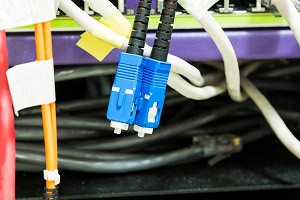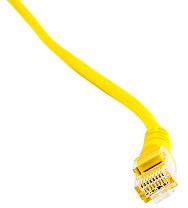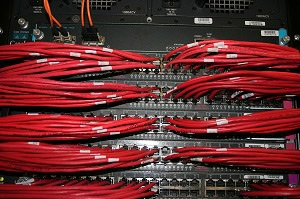What are Network and Telecom connectors?
Network and telecom connectors include the popular RJ–the acronym stands for Registered Jack–connectors, which are used in just about every office, business and industrial setting imaginable. The connectors include designs that are intended for very rugged use and designs that are intended for everyday use in environments such as offices.
Increasingly, network and telecom connectors are designed to be used with fiber-optic technology, one of the most significant advances in telecom technology in recent decades.
Even the RJ connectors that are so ubiquitous actually represent impressive innovations in the history of telecom. These did not come into common usage until the mid-1960s and, because of their easy to use design and durable nature, they remain in widespread use today.
Network connectors are typically able to be differentiated from telecom connectors by sight. The RJ 11, RJ 14 and other jacks commonly used for telephone connections are smaller than the RJ-45 jacks use for most Ethernet applications.
What are Network and Telecom Connectors used for?Network and telecom connectors are used to transmit data and to provide telephony services all over the world. There is an enormous range of RJ connectors available on the market, each of them with its own connector and usage, though some of them overlap in terms of usages.
RJ connectors sometimes differ based on the number of telephone lines that are installed on a given telecom system and, where data transmission is concerned, there are different wiring arrangements available via different connectors.
Network and telecom connectors are among the most widely used types of connectors in existence. Most home users have an Ethernet cord running from their modem to their computer, which utilizes a telecom connector on both ends. Between telephones, computers, network hubs and other hardware, these connectors are exceptionally common.
What Types of Network and Telecom Connectors Exist?
Telecom connectors include several different types, but they are generally standardized, which makes it much easier for technicians, engineers and system designers to get exactly the parts they need for any given task.
The very common Registered Jack connectors are likely to be a part of any telecom design. Cords with these connectors pre-attached are readily available, though the kits for terminating and providing a cable with this type of a connection are also widely available and most telecom technicians are familiar with their usage.
Some telecom jacks represent slight variations on conventions. For example, MMJ connectors are slightly modified versions of a standard RJ connector but are not compatible with other RJ connectors.
Fiber-optic connectors are the newest entries into the world of telecom connectors and are quite common these days. Most major telephone carriers have added fiber-optic technology to their mainlines and, increasingly, these types of connectors are finding a home within businesses, industrial installations and so forth as fiber-optic technology becomes more readily available and less expensive.
Worldwide, there are different types of connectors utilized for telecom purposes, though there is quite a bit of standardization in the industry. Network and telecom connectors are, above all other things, designed to be easy to install, easy to splice onto the end of a cable and very durable. These complicated connectors have been refined to the point that most end-users can successfully hook up a phone or a network switch without any difficulty, owing to the fact that the connectors only fit in the appropriate port one way and that inappropriate connectors do not fit correctly in the wrong ports.
What are Communication & Networking Attenuators?
Attenuators are devices that are designed to reduce the power of a signal. These devices can do this without introducing distortion into the signal.
These devices are also used to make impedance matching more accurate. These devices are very simple but, in many ways, modern telecommunications technology depends upon them a great deal to provide consistent and reliable signal across lines.
Fiber Optic Connectors
Fiber-optic connectors allow technicians to join optical fiber cable without splicing. These connectors have to provide a continuous connection and there is little tolerance for improper connection in fiber-optic technology.
Because fiber-optic cable carries light, specialized tools are often employed to splice fiber-optic cables together.
What are Fiber Optic Connectors?
Fiber-optic connectors are designed to allow convenient splicing of fiber-optic lines and the hooking a fiber-optic lines up to larger systems. They are differentiated by being categorized into standardized types, including SC, FC, LC and others. The SMA designation is utilized for higher power applications were fiber-optic cables have to be joined. These connectors are very precise and they provide an exceptionally strong connection. Even when connectors are utilized that make it easy to terminate and install a connectors, there is a very involved process that must be undertaken involving cleaning off the fibers, joining them correctly and so forth. These are generally devices that require much more precision and skill to use than a standard telecom connector.
How do Fiber Optic Connectors work?
Fiber-optic connectors consist of a metal cylinder and a sleeve. These connectors are often designed to lock together very securely, often with the use of a latch or a threaded connector. The fiber-optic cable is threaded through the body of the connector and adhesive is used to secure the fiber in place. Another device utilized to eliminate stress on the fiber-optic cable is installed in the rear of the connector. In order to properly join the lines, the ends of the fiber have to be polished in a very specific way that ensures a good connection.
Some fiber-optic cables are designed to be spliced together more easily than was possible in the past. These fiber-optic cables typically have pre-polished surfaces and some of them include a gel in the line that makes connecting lines together much easier.

What are Fiber Optic Kits?
Because working with fiber-optic cable is such a complicated endeavor, there are kits available that come with everything that is required to perform various tasks on fiber-optic lines. Fiber optic kits generally include all of the tools needed to perform a specific repair or to test a line. For example, termination kits come with everything required to successfully terminate a fiber-optic line, from the polishing tool to the stripper used to clean off the lines.
Evaluation kits make it easy for technicians to get an idea of whether or not a fiber-optic line is in good condition. They contain all the necessary tools and help technicians to avoid situations where they figure out that they need one more vital tool and they don've it on hand.
What are Fiber Optic Patch Panels?
Fiber-optic patch panels allow many different lines to be joined together into a single system. These devices can be mounted in various locations, depending upon their design. Fiber-optic patch panels are designed with different types of ports, different types of modes and other features that make them appropriate for specific applications.
Fiber Optic Patch Panel Accessories
Fiber-optic patch panel accessories include trays, cassettes, blanking plates and other devices that are utilized in the construction of fiber-optic panels. These devices are sometimes purchased to replace worn-out devices but, when a new patch panel is being constructed, many of these devices typically have to be purchased to complete the job.
These accessories are differentiated by the types of connectors that they take, the type of optical fiber they are capable of working with, whether they have simplex or duplex communication and other criteria. The number of ports available on any given accessory is also an important consideration that any technician has to take into account.
What are MMJ Connectors?
Modified Modular Jack connectors, usually abbreviated MMJ, are a specific type of variation on the 6P6C modular connector. MMJ connectors are virtually identical to the aforementioned connectors, save for the fact that the hook on the connector is located on the side of the plug. On a 6P6C connector, the hook is located in the center of the plug.
These plugs are used to connect minicomputers and peripheral devices. Because of the placement of the hook on these connectors, they are not compatible with the 6P6C connectors.
What are RJ Connectors?
A Registered Jack, usually abbreviated RJ, represents one of the most common standardized networking interfaces in the world. These connectors are rectangular, made out of plastic and have a hook that latches them in place when they are inserted in an appropriate receptacle.
RJ connectors are very common in North America. These connectors, however, are used around the world, to some extent. These connectors have the advantage of a standardized wiring pattern, which makes it much easier for technicians to ensure that devices are hooked together correctly. RJ connectors are used on simple phone lines as well as in data transmission lines.
What Types of RJ Connectors Exist?
There are several different types of RJ connectors, differentiated by the number of wires they have, the shape of the connector and the size of the connector. Some of these connectors are cross compatible though others are deliberately made incompatible.
RJ11 Connectors
RJ11 connectors are very common types of phone connectors. These are small connectors and most people likely have examples of them in their homes.
RJ12 Connectors
RJ12 connectors are utilized for telephone systems that have one line ahead of the key system.
RJ14 Connectors
The RJ14 connector is utilized on telephone systems that have two telephone lines installed.
RJ22 Connectors
RJ 22 connectors are utilized and telephone systems and have two wires hooked up in them. RJ 24 connectors are identical, but have four wires.
RJ25 Connectors
RJ25 connectors are smaller than other telephone connectors. They'ypically utilized to connect handsets to devices.
RJ45 Connectors
RJ45 connectors are utilized for data and are commonly seen on the ends of Internet cables.

RJ50 Connectors
RJ 50 connectors are also referred to as 10P10C connectors. They have 10 contacts in them and 10 contact positions available. These are utilized for data transfer by several different vendors. These are also sometimes utilized as connectors for microphones for mobile radios.
What Accessories Exist for RJ Connectors?
There are numerous different accessories available for RJ connectors. These make it possible to connect different systems together, to better protect lines against damage and provide many other useful advantages, as well.
RJ Adapters, Couplers & Extensions
RJ Adapters, couplers and extensions are utilized to extend cords, to hook cords together and to allow different types of jacks to be connected via an adapter. There are many different types of accessories available in this category and, because RJ adapters are so common, there are also many different types of adapters designed to make otherwise incompatible lines able to communicate.
RJ Connector Hoods & Boots
RJ Connector hoods and boots provide protection for RJ connectors. These are particularly vital in environments –as industrial settings – the connectors are likely to be exposed to environmental contaminants, mechanical force or other potential sources of damage.
RJ Kits
RJ kits provide technicians with everything they need to perform various tasks on lines utilizing RJ connections and to install RJ connectors, where needed. They often include splicers and other tools that make it easier for technicians to do their work.
RJ Patch Panel Modules & Accessories
RJ Patch panel accessories include everything that is needed to customize a patch panel for a business or a home. These include hardware designed for mounting, adding lines and so forth.
RJ Patch Panels
RJ patch panels bring together many different lines into one panel where they can all be controlled. These are very common features in networking rooms, are designed to be easy to work with and are very long-lasting.
RJ Socket Modules & Blanks
RJ Socket modules and blanks make it easy for installers to put RJ connection receptacles into walls and other locations. They also provide for greater physical security for the network, as they provide reliable and tough connections that are unlikely to develop issues, even having been installed long in the past and been in use for a very long time.
